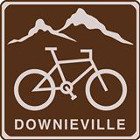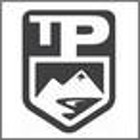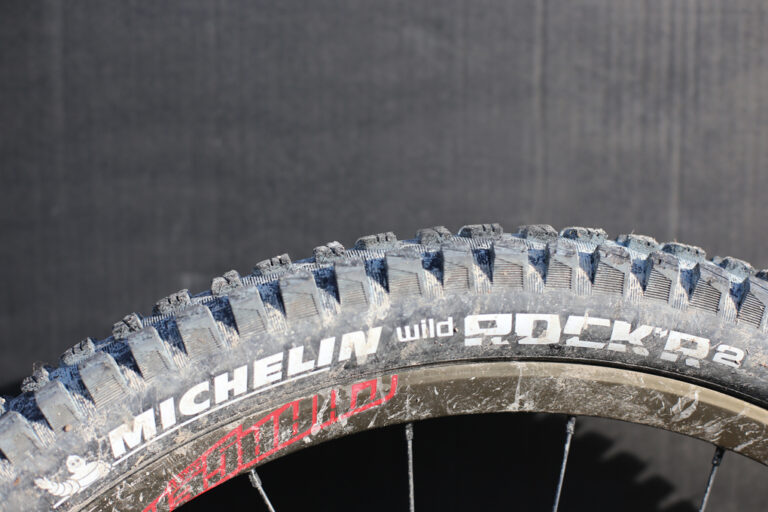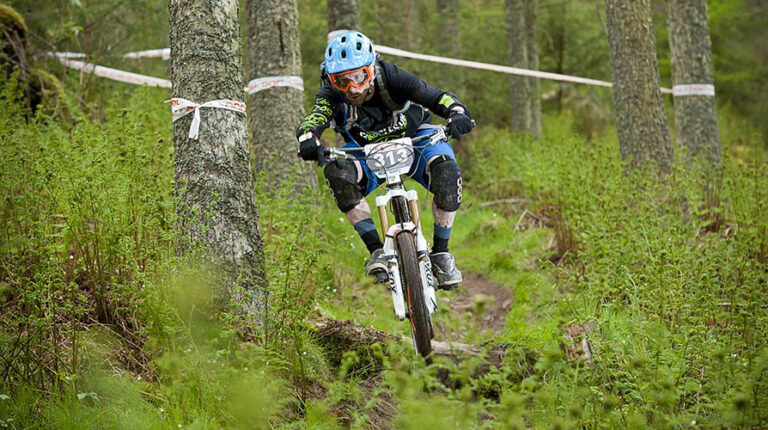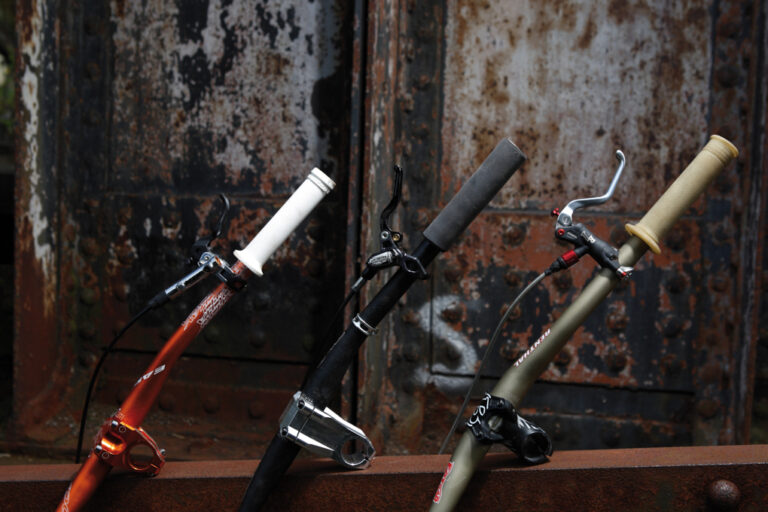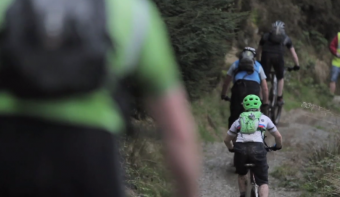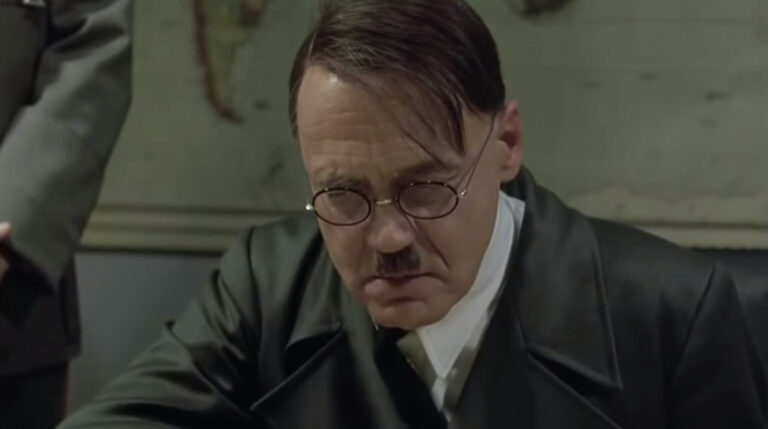 Locations/Dates: Alpe d’Huez 8–10th July/Ile De Reunion 26–27th November
Locations/Dates: Alpe d’Huez 8–10th July/Ile De Reunion 26–27th November
Price: 5 Day pass and race €84
2010 Winner: JEROME CLEMENTZ 56mins 2sec
Description: A mass start event in which your start grid position is determined after taking on the thirty minute qualification run from a lower altitude. Probably the largest downhill, entries for this annual classic have headed into thousands. The final features a colossal arm wrestle off the start to get a position for a race that can take many riders up to an hour and a half to complete. Loud music, helicopters overhead and all the top pros. A classic.
Rider’s view: Steve JonesNothing quite prepares you for the final, not even the 40 rider knuckle to knuckle start grid of the qualifiers. 5am at the summit of Pic Blanc at 10,000ft is dry, cold, breathless, you are enveloped with anticipation, and you need a shit. You are about to enter into a void not quite knowing the limits you will have to push yourself. One of the hardest races I’ve ever done (Ed note: and there was no snow at the top when he did it).
 Mega years
Mega years
The beginnings of French Domination
Interview with George Edwards
George: Our programme has three emblematic events: the Avalanche Cup in Lyon, the Transvésubienne and the Megavalanche. The Avalanche Cup in Lyon is the ‘Queen’ of Sprint Downhill in the centre of one of the largest cities in Europe. It is not only a real show, but is as well an international competition. Transvésubienne is a unique event in the world, which requires all the qualities that the MTB discipline wants and especially lots of technical mastery.
The Megavalanche in Alpe d’Huez remains a must for All–Mountain Enduro enthusiasts. Ski lifts, track configuration and facilities add to the fact that the Megavalanche was the first competition to showcase the versatility of the Enduro spirit as early as 1995. Because of this, it is the greatest downhill race in the world. The other reason for the success of this race is that this event has been progressing with time.
The Maxiavalanche in Europe has remarkable tracks such as Cervinia in Italy, Vallnord in Andorra, Flims in Switzerland and Åre in Sweden, but their creation is more recent. Riders of these countries are not so keen on Enduro (or versatile MTB) as the French, and to a lesser degree the British, are. As far as Enduro is concerned, the formula has a great success, but current means of organization limits the number of participants to this type of race to 250 or 300 maximum.
Races on mid–travel bikes are successful, which way is it heading?Mountain bikes equipped with mid travel suspension ideally matches the founder spirit of the sport. Thanks to the technology applied on all the components, the geometry and the transmission, the practitioners have even increased in pleasure of use because, beyond the effort, the MTB is all about the dexterity, the game and the discovery. And, contrary to their elders that were very specialised (downhillers or XC riders) the current generation of rider excels in all areas. The Megavalanche and Maxiavalanche are the only events where there is the equality of World Champions of XC and DH, like Julien Absalon, Nino Schurter and Fabien Barel confronting each other. I feel that the mountainbike is already committed towards versatility and an Olympic XC course will, in the long term, be more technical.
The top ten at the Mega has always been dominated by riders on home soil. Why is this do you think? And not only your events but other enduro stage downhill are dominated by the French, the Megavalanche must have played a part in developing this type of rider.There are many French riders in the Top 10 because our country has created very favourable conditions for the mountainbiking since 1987. The support of a number of great mountain resorts which had a vision, both economic and touristic, plus the know–how and passion of many of the first mountainbikers – the values of mountain bike have evolved and have been preserved. France was the first nation to organise a national cup for downhill in 1990, and create in 1991 a Cup of France of combined stages that today is called Enduro.
It was also the first and only nation in the world to create a national trophy for young bikers in 1992 while being based on the structure of a national team. This allowed children from 9 to 14 years to race a real program of competitions (departmental, regional and national). And it was versatile because all the young participants performed in a downhill race, XC and a trial. Then Megavalanche came in 1995 to Alpe d’Huez and l’Ile de la Réunion, causing the wave on which we surf, always and for a long time, the versatile MTB.
In terms of entries what has been the spread of nations over the past 16 years?Paradoxically, the most reactive nation of alpine riding and especially at the Megavalanche, is the United Kingdom, they have as many competitors as France. Germany is now the third nation in the number of participants and the biggest potential for riders. However this country still lacks a fundamental culture of mountain biking. German events are performed on tracks or in ways that are much too simple and marathon orientated. Another remarkable nation in the All Mountain Enduro is Switzerland, mainly because of the performances by their leaders: Nino Schurter, Rene Wildhaber and Florian Golay are still very powerful. Spain and Italy are also into alpine mountain biking.
Most of the big name World Cup stars have come and had a go, yet Vouilloz and Chausson are still the only ones to succeed at the Mega.Many holders of World XC or DH titles have raced the Megavalanche and Maxiavalanche. Steve Peat and Cédric Gracia, who won the Megavalanche of l’Ile de la Réunion in 2001 and 2002 and, of course, Nicolas Vouilloz. Now they practice at the same level as the best All Mountain Enduro riders – Rémy Absalon, Jérome Clémentz or Rene Wildhaber, who excel in many areas: strength, endurance, temerity, dexterity, management of equipment and mentally. And Anne Caroline Chausson? She is an exception because she excels in everything she undertakes in competitions; other women will not exceed her experience and qualities for a long time.
Are you surprised it has taken so long for similar longer downhill stage events to catch on in Europe?Since the creation of our Megavalanche circuit, we always wanted organize similar events abroad to be used as references and models for the development of Enduro. We went to Cuzco in Peru and also supported a Megavalanche organization in Japan. Because of the lack of international partners and a difficult economic situation we have no dates outside of Europe this year, but we have many projects, including one in Mexico.
On the other hand, it is necessary to continue the promotion of this practice among our Italian, Spanish and (especially) German friends, and to move this new school even more to the East. For example, it is surprising that Austria doesn’t have many riders and doesn’t organize a Maxiavalanche Europe Cup. However, there is a big potential in all of these countries: Slovenia, Poland, and Hungary, that we encourage riders to come to our events with preferential rates.
Last year was first year in which less than half the top ten were French? Are things changing?The French almost exclusively occupied World Cups downhill podiums between 1994 and 2000. Now the UK, and English speaking countries, take the first places. This is a sign of renewal of the sport and its riders.
Maxiavalanche
Locations/Dates: Vallnord 11–12 June/Cervinia 30–31 July/Are 26–27 August/Flims 2 October
Price: 5 Day pass and race €84
2010 Final Winner, Flims: Nino Schurter 18mins 31sec
Description: Twenty–minute descent, twice. Run by the Avalanche Cup team, the Maxiavalanche takes racing to some of the lesser–known, but nonetheless intense, locations in Europe.
Rider’s view: Alex LangleySat on the start line of a Maxiavalanche race, the day is going to go one of two ways: Blitz the start and disappear off in a helmet filled with a mix of dust, wheezing and euphoria OR lose a 300–person, bonkers, high–speed lottery and ride a wave of frustration for the next 15 minutes trying to pass guys with massive rucksacks.
One of two ways, eh? Here’s the catch, you don’t just have to flip this coin of fate once, but twice. Unlike the better known Megavalanche races, a Maxi consists of two heats on finals day, meaning that upon reaching the finish line with a broken bike and bruised pride things have to be turned around pretty quickly to get back up the hill for round two. The Maxiavalanche Europe Cup is a seriously formidable race series.
From the southern dust and madness of Andorra to the northern rocks and mist of Sweden, Maxiavalanches take in some terrifically varied terrain and cultures. The biggest names in enduro compete in the series, with Remy Absalon, arguably one of the best enduro racers on the planet, taking the 2010 crown.
The varied nature of this series is reflected not only in the tracks and the countries that host them, but also in the people and the trusty (or occasionally not–so–trusty) steeds that come to participate. Racing on track can be equally competitive between a cross–country racer and a downhill racer, a veteran and a junior, a trail bike and a freeride monster. It is this that makes Maxiavalanche races so special; it reminds us that there is no need for barriers or divides, marketing spiel pigeon–holing people into different ghettos of cycling, but that we are all one on two wheels.

 Mega years
Mega years